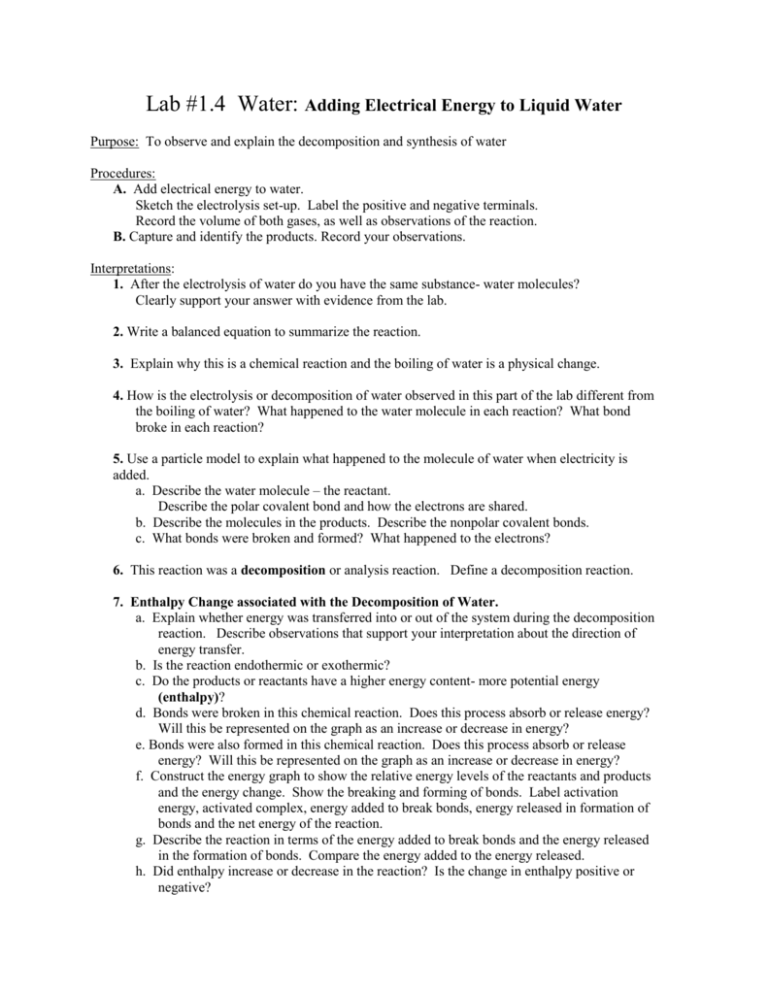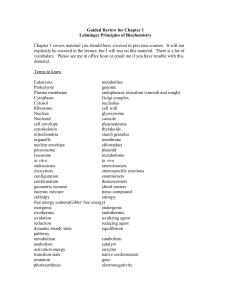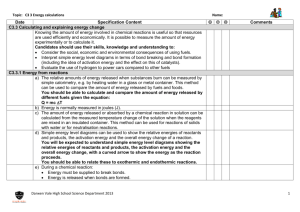Lab 1.4
advertisement

Lab #1.4 Water: Adding Electrical Energy to Liquid Water Purpose: To observe and explain the decomposition and synthesis of water Procedures: A. Add electrical energy to water. Sketch the electrolysis set-up. Label the positive and negative terminals. Record the volume of both gases, as well as observations of the reaction. B. Capture and identify the products. Record your observations. Interpretations: 1. After the electrolysis of water do you have the same substance- water molecules? Clearly support your answer with evidence from the lab. 2. Write a balanced equation to summarize the reaction. 3. Explain why this is a chemical reaction and the boiling of water is a physical change. 4. How is the electrolysis or decomposition of water observed in this part of the lab different from the boiling of water? What happened to the water molecule in each reaction? What bond broke in each reaction? 5. Use a particle model to explain what happened to the molecule of water when electricity is added. a. Describe the water molecule – the reactant. Describe the polar covalent bond and how the electrons are shared. b. Describe the molecules in the products. Describe the nonpolar covalent bonds. c. What bonds were broken and formed? What happened to the electrons? 6. This reaction was a decomposition or analysis reaction. Define a decomposition reaction. 7. Enthalpy Change associated with the Decomposition of Water. a. Explain whether energy was transferred into or out of the system during the decomposition reaction. Describe observations that support your interpretation about the direction of energy transfer. b. Is the reaction endothermic or exothermic? c. Do the products or reactants have a higher energy content- more potential energy (enthalpy)? d. Bonds were broken in this chemical reaction. Does this process absorb or release energy? Will this be represented on the graph as an increase or decrease in energy? e. Bonds were also formed in this chemical reaction. Does this process absorb or release energy? Will this be represented on the graph as an increase or decrease in energy? f. Construct the energy graph to show the relative energy levels of the reactants and products and the energy change. Show the breaking and forming of bonds. Label activation energy, activated complex, energy added to break bonds, energy released in formation of bonds and the net energy of the reaction. g. Describe the reaction in terms of the energy added to break bonds and the energy released in the formation of bonds. Compare the energy added to the energy released. h. Did enthalpy increase or decrease in the reaction? Is the change in enthalpy positive or negative? i. Is the reaction favored based upon enthalpy? 8. Entropy Change associated with the Decomposition of Water a. Did entropy increase or decrease in the reaction? Explain your reasoning. b. Is this reaction favored based upon entropy? 9. The reverse reaction is a synthesis reaction. Define synthesis. Write an equation for the synthesis of water. 10. Predict whether the synthesis of water will be endothermic or exothermic. Explain your prediction. 11. Enthalpy Change associated with the Synthesis of Water. a. Explain whether energy was transferred into or out of the system during the decomposition reaction. Describe observations that support your interpretation about the direction of energy transfer. b. Is the reaction endothermic or exothermic? c. Do the products or reactants have a higher energy content- more potential energy (enthalpy)? d. Construct the energy diagram to show the relative energy levels of the reactants and products and the energy change. Label activation energy, activated complex, energy added to break bonds, energy released in formation of bonds and the net energy of the reaction. e. Describe the reaction in terms of the energy added to break bonds and the energy released in the formation of bonds. Compare the energy added to the energy released. f. Did enthalpy increase or decrease in the reaction? g. Is the reaction favored based upon enthalpy? 12. Collision Model and Rates of Reaction. Hydrogen and oxygen gas were both present in the test tube at room temperature, yet no noticeable reaction occurred. a. Use collisions, activation energy (the energy required to break bonds), effective collisions, and temperature to explain why the reaction does not occur at a noticeable rate at room temperature, but does occur when a spark is added. b. When the spark is added the reaction was explosive. Was more energy added to break the bonds or released when the new bonds formed? Explain. 13. Intermolecular Forces of Attractions (IMF) and States of Matter. Water was liquid at room temperature, while hydrogen and oxygen were gases at room temperature. Particle attractions (intermolecular forces- IMF) can be used to explain this. a. Describe and name the bond that holds together the hydrogen and oxygen atom in a water molecule. Does this lead to oppositely-charged ends? b. Describe and name the bond that holds together the hydrogen atoms in a molecule of hydrogen gas. Describe and name the bond that holds together the oxygen atoms in a molecule of oxygen gas. Does this lead to oppositely-charged ends? c. Use bonding and intermolecular forces to explain why water is a liquid and oxygen and hydrogen are gases at room temperature. Compare the IMF in water to that in hydrogen and oxygen gas. PART 5. Conclusion: Discuss the changes in water that result from heating. Explain how this is a physical change. Include the changes on both an atomic level and molecule level. What kind of bonds were broken? How was energy involved in these changes? Include diagrams and graphs as need to fully develop the ideas. Discuss the changes in water that result adding electricity. Explain how this is a chemical change. Include the changes on both an atomic level and molecule level. What kind of bonds were broken? How was energy involved in these changes? Include diagrams and graphs as need to fully develop the idea PART 5. Conclusion: Discuss the changes in water that result from heating. Explain how this is a physical change. Include the changes on both an atomic level and molecule level. What kind of bonds were broken? How was energy involved in these changes? Include diagrams and graphs as need to fully develop the ideas. Discuss the changes in water that result adding electricity. Explain how this is a chemical change. Include the changes on both an atomic level and molecule level. What kind of bonds were broken? How was energy involved in these changes? Include diagrams and graphs as need to fully develop the idea PART 5. Conclusion: Discuss the changes in water that result from heating. Explain how this is a physical change. Include the changes on both an atomic level and molecule level. What kind of bonds were broken? How was energy involved in these changes? Include diagrams and graphs as need to fully develop the ideas. Discuss the changes in water that result adding electricity. Explain how this is a chemical change. Include the changes on both an atomic level and molecule level. What kind of bonds were broken? How was energy involved in these changes? Include diagrams and graphs as need to fully develop the idea PART 5. Conclusion: Discuss the changes in water that result from heating. Explain how this is a physical change. Include the changes on both an atomic level and molecule level. What kind of bonds were broken? How was energy involved in these changes? Include diagrams and graphs as need to fully develop the ideas. Discuss the changes in water that result adding electricity. Explain how this is a chemical change. Include the changes on both an atomic level and molecule level. What kind of bonds were broken? How was energy involved in these changes? Include diagrams and graphs as need to fully develop the idea









